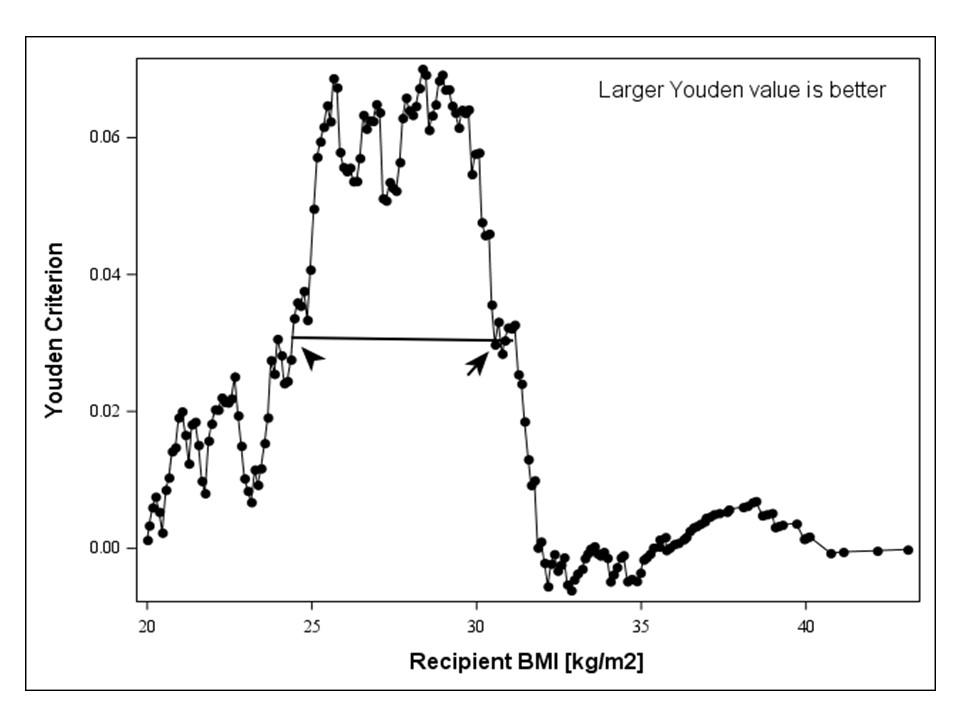Access to Simultaneous Pancreas and Kidney Transplant (SPK) Should Not Be Restricted to BMI > 28.
SUNY Upstate Medical University, Syracuse, NY
Meeting: 2017 American Transplant Congress
Abstract number: 178
Keywords: Kidney/pancreas transplantation, Obesity, Outcome, Pancreas transplantation
Session Information
Session Name: Concurrent Session: Pancreas Transplantation
Session Type: Concurrent Session
Date: Sunday, April 30, 2017
Session Time: 4:30pm-6:00pm
 Presentation Time: 5:30pm-5:42pm
Presentation Time: 5:30pm-5:42pm
Location: E267
Background: Currently, UNOS guidelines require that uremic, insulin-dependent type 1 diabetic patients have a body mass index (BMI) < 28m/kg2 in order to be eligible for a SPK. The BMI cutoff of 28 kg/m2 for SPK appears to be arbitrary. The study purpose was to reassess BMI requirements.
Methods: To determine the impact of recipient BMI outcomes, we examined the results of 3,326 primary deceased donor SPKs that were reported to UNOS/IPTR between 2010 and 2014. In this cohort, 2% of recipients were underweight (<18.5kg/m2), 53% had a normal BMI (BMI 18.5 – <25kg/m2), 35% were overweight (BMI 25 -< 30kg/m2), and 12% obese (BMI > 30kg/m2) at the time of tx. In the obese patients, 6% had a BMI > 32kg/m2. A multivariate analysis of early technical failures and 1-year pancreas graft function according to recipient BMI was performed and adjusted for donor, recipient and transplant factors management. The Younden criterion was computed to estimate the optimal range for recipient BMI.
Results: Overall SPK recipient survival, pancreas and kidney graft function at 1 year were 97.5%, 90.1%, 95.6%.
The most influential risk factors for technical failures over the 5-yr study period were increased donor age (> 30 yrs), no induction therapy, and PRA level > 20%. All other risk factors, including BMI, did not reach significance. Of note, early graft failures due to rejection (specifically in the absence of induction and standard maintenance [Tac, MMF] therapy) may have been misdiagnosed as technical complications. In addition to the technical risk factors, large center volume showed a reduced risk of pancreas graft loss at 1-year post transplant. However, recipient BMI did not reach significance (p=0.44) in any of the multivariate analyses. Figure 1 shows the optimal BMI range (25 -32 kg/m2).  Summary: Based on this current 5-yr analysis the requirement of <28 BMI for SPK candidates should be lifted and eventually abandoned. This requirement restricts patient access to a much needed transplant procedure with excellent outcome. We recommend as a first step that all SPK candidates with a BMI ≤ 32 kg/m2 should be evaluated for transplantation.
Summary: Based on this current 5-yr analysis the requirement of <28 BMI for SPK candidates should be lifted and eventually abandoned. This requirement restricts patient access to a much needed transplant procedure with excellent outcome. We recommend as a first step that all SPK candidates with a BMI ≤ 32 kg/m2 should be evaluated for transplantation.
CITATION INFORMATION: Laftavi M, Gruessner A, Whittaker V, Acun Z, Pankowycz O, Gruessner R. Access to Simultaneous Pancreas and Kidney Transplant (SPK) Should Not Be Restricted to BMI > 28. Am J Transplant. 2017;17 (suppl 3).
To cite this abstract in AMA style:
Laftavi M, Gruessner A, Whittaker V, Acun Z, Pankowycz O, Gruessner R. Access to Simultaneous Pancreas and Kidney Transplant (SPK) Should Not Be Restricted to BMI > 28. [abstract]. Am J Transplant. 2017; 17 (suppl 3). https://atcmeetingabstracts.com/abstract/access-to-simultaneous-pancreas-and-kidney-transplant-spk-should-not-be-restricted-to-bmi-28/. Accessed January 7, 2026.« Back to 2017 American Transplant Congress
